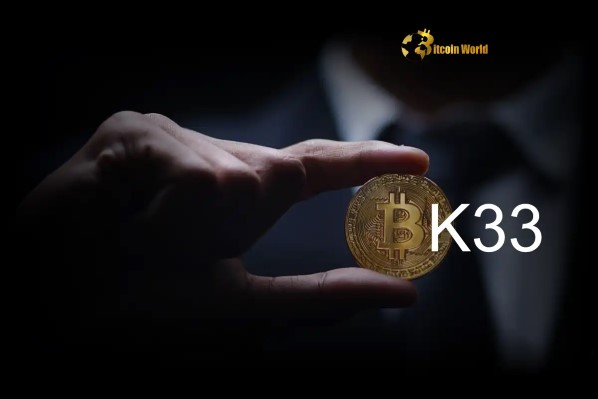BitcoinWorld

Bitcoin’s Unstoppable Reign: Why Pompliano Crowns It ‘King of Wall Street’
In the dynamic world of finance, few assets command attention quite like Bitcoin. What was once considered a niche digital curiosity has undeniably ascended to the forefront of investment conversations, captivating both individual enthusiasts and institutional giants alike. Recently, a powerful declaration from a prominent voice in the crypto space has echoed across financial markets, solidifying Bitcoin’s burgeoning status. Anthony Pompliano, the insightful founder and CEO of ProCapBTC, didn’t mince words during a recent CNBC interview, boldly proclaiming that Bitcoin has transitioned from a fringe investment into a widely embraced asset, unequivocally calling it “the king of Wall Street.” This isn’t just hyperbole; it’s a reflection of a profound shift in how the financial world perceives and integrates the leading cryptocurrency.
The Coronation: Why Bitcoin is ‘King of Wall Street’
Pompliano’s pronouncement isn’t made in a vacuum. It stems from a meticulous observation of market trends and economic shifts that highlight Bitcoin’s superior performance and increasing relevance. His argument is multi-faceted, drawing on critical comparisons with traditional financial benchmarks. The essence of his claim lies in Bitcoin’s remarkable resilience and appreciation, especially when contrasted with the weakening purchasing power of fiat currencies and the underperformance of conventional equities.
- Erosion of Fiat Purchasing Power: One of Pompliano’s key points, as highlighted by Wu Blockchain, is the significant decline in the U.S. dollar’s purchasing power. Over the past five years, the dollar has reportedly seen a roughly 30% reduction in its value. This erosion means that holding traditional cash assets has resulted in a substantial loss of wealth over time, making a compelling case for alternative stores of value.
- S&P 500’s Underperformance Against Bitcoin: Perhaps even more striking is the comparison between the S&P 500, a cornerstone of traditional investment, and Bitcoin. Since 2020, the S&P 500 has plummeted by more than 85% when its performance is measured in Bitcoin. This stark contrast underscores Bitcoin’s exponential growth and its potential as a superior long-term investment, outshining even the most robust stock market indices.
- Institutional Embrace: The ‘king’ status isn’t just about performance; it’s about acceptance. Wall Street, once skeptical, is now actively integrating Bitcoin. The approval of spot Bitcoin ETFs in the U.S. has opened floodgates for institutional capital, providing regulated and accessible avenues for major players to gain exposure to the digital asset.
Decoding the Institutional Embrace: Who’s Adopting Bitcoin and Why?
The journey of Bitcoin from a fringe asset to a Wall Street darling is largely attributed to the growing institutional embrace. This isn’t a sudden phenomenon but a gradual recognition of Bitcoin’s unique attributes and its role in a diversified portfolio. But who exactly is adopting Bitcoin, and what are their motivations?
Major Players Entering the Bitcoin Arena:
The list of institutions exploring or directly investing in Bitcoin is growing. This includes:
- Asset Managers: Firms like BlackRock, Fidelity, and Grayscale have launched Bitcoin ETFs, allowing their vast client bases to invest in Bitcoin without directly holding the asset.
- Publicly Traded Corporations: Companies like MicroStrategy have made significant Bitcoin acquisitions, integrating it into their treasury reserves as a hedge against inflation and a growth asset.
- Hedge Funds and Family Offices: These sophisticated investors are allocating portions of their portfolios to Bitcoin, seeking diversification and asymmetric returns.
- Payment Processors: Companies like PayPal and Square (Block Inc.) have integrated Bitcoin into their services, making it more accessible for everyday transactions and investment.
What are the Driving Forces Behind This Bitcoin Adoption?
Several factors are propelling this institutional shift towards Bitcoin:
| Factor | Explanation |
|---|---|
| Inflation Hedge | With unprecedented monetary easing and rising inflation concerns globally, institutions view Bitcoin’s finite supply (21 million coins) as a robust hedge against currency debasement, much like digital gold. |
| Digital Gold Narrative | Bitcoin shares characteristics with gold – scarcity, divisibility, and portability – but offers superior digital transferability and resistance to censorship. It’s increasingly seen as a modern store of value. |
| Diversification Benefits | Bitcoin’s low correlation with traditional asset classes (stocks, bonds) makes it an attractive tool for portfolio diversification, potentially reducing overall risk while enhancing returns. |
| Technological Innovation | Institutions recognize the underlying blockchain technology as a groundbreaking innovation with potential to revolutionize various industries beyond finance, making Bitcoin an early-stage investment in this future. |
| Growing Regulatory Clarity | The emergence of clearer regulatory frameworks, particularly in major economies, has provided institutions with the confidence and legal certainty needed to engage with digital assets. |
Navigating the Bitcoin Landscape: Challenges and Opportunities
While Bitcoin’s ascent is undeniable, it’s crucial to acknowledge that the journey isn’t without its complexities. Like any investment, Bitcoin presents both significant opportunities and inherent challenges that investors must consider.
Potential Challenges for Bitcoin Investors:
- Volatility: Bitcoin is known for its price swings, which can be significant. While this volatility presents opportunities for gains, it also carries substantial risk of losses.
- Regulatory Uncertainty: Despite progress, the regulatory landscape for cryptocurrencies remains evolving and fragmented across different jurisdictions, which can introduce uncertainty.
- Security Risks: While the Bitcoin network itself is highly secure, individual investors face risks related to secure storage (wallets), phishing attacks, and exchange hacks if proper precautions are not taken.
- Market Manipulation: The relatively nascent nature of the crypto market compared to traditional finance means it can be more susceptible to large-scale market manipulation.
Unlocking Opportunities with Bitcoin:
Despite the challenges, the opportunities Bitcoin offers are compelling:
- Asymmetric Upside: Many believe Bitcoin still has significant growth potential, offering a disproportionately high return relative to its current valuation compared to traditional assets.
- Global Accessibility: Bitcoin is a borderless asset, accessible to anyone with an internet connection, facilitating global transactions and financial inclusion.
- Inflation Protection: As highlighted by Pompliano, Bitcoin’s fixed supply makes it a strong candidate for protecting wealth against inflationary pressures.
- Technological Disruption: Investing in Bitcoin is also an investment in the broader blockchain technology, which is poised to disrupt numerous industries.
Actionable Insights for Engaging with Bitcoin
For those looking to understand or participate in the Bitcoin market, here are some actionable insights:
- Do Your Own Research (DYOR): Before investing, thoroughly understand Bitcoin’s technology, economics, and market dynamics. Don’t rely solely on headlines or social media trends.
- Start Small and Dollar-Cost Average (DCA): Given Bitcoin’s volatility, consider investing a small, fixed amount regularly (e.g., weekly or monthly) rather than a large lump sum. This strategy helps mitigate risk over time.
- Secure Your Holdings: Use reputable exchanges and consider hardware wallets for larger holdings to enhance security against hacks and theft.
- Understand Your Risk Tolerance: Bitcoin is a high-risk, high-reward asset. Only invest what you can afford to lose.
- Stay Informed: The crypto space evolves rapidly. Follow reliable news sources, industry experts, and market analysis to stay updated on developments.
The Enduring Reign of Bitcoin: A Compelling Future
Anthony Pompliano’s bold assertion that Bitcoin is now ‘the king of Wall Street’ is more than just a catchy phrase; it’s a testament to a profound paradigm shift in global finance. The data, from the eroding purchasing power of the U.S. dollar to the stark underperformance of the S&P 500 when measured against Bitcoin, paints a clear picture of a digital asset that is not only holding its own but aggressively gaining ground against traditional financial stalwarts. The increasing institutional embrace, driven by Bitcoin’s role as an inflation hedge, a diversifier, and a technological innovation, signals a future where digital assets play an ever more central role. While challenges remain, the opportunities presented by Bitcoin’s unique attributes continue to attract significant capital and attention, solidifying its position at the pinnacle of modern investment. As Wall Street increasingly bows to its new monarch, the reign of Bitcoin appears set to continue, reshaping the very foundations of wealth and value.
Frequently Asked Questions (FAQs)
Q1: What does Anthony Pompliano mean by calling Bitcoin ‘the king of Wall Street’?
Anthony Pompliano means that Bitcoin has surpassed traditional assets in terms of relevance, performance, and institutional adoption, becoming the most significant and influential asset for major financial players on Wall Street. He cites its superior returns compared to the S&P 500 and its ability to maintain purchasing power against the depreciating U.S. dollar.
Q2: How has Bitcoin performed against the U.S. dollar and the S&P 500?
According to Pompliano, the U.S. dollar’s purchasing power has declined by approximately 30% over the past five years. In contrast, the S&P 500 has dropped more than 85% when its performance is measured in Bitcoin since 2020, highlighting Bitcoin’s significant outperformance as an investment.
Q3: Why are institutions increasingly embracing Bitcoin?
Institutions are embracing Bitcoin for several reasons, including its potential as an inflation hedge due to its finite supply, its role as ‘digital gold’ for portfolio diversification, the increasing regulatory clarity surrounding digital assets, and the recognition of its underlying blockchain technology as a major innovation.
Q4: What are the main risks associated with investing in Bitcoin?
Key risks include high price volatility, ongoing regulatory uncertainties across different jurisdictions, security risks related to digital asset storage and exchanges, and the potential for market manipulation in a relatively nascent market.
Q5: What is ‘Dollar-Cost Averaging’ (DCA) and why is it recommended for Bitcoin?
Dollar-Cost Averaging (DCA) is an investment strategy where you invest a fixed amount of money at regular intervals, regardless of the asset’s price. It’s recommended for Bitcoin to mitigate the impact of its high volatility, as it averages out the purchase price over time and reduces the risk of buying at a single price peak.
If you found this article insightful, consider sharing it with your network on social media! Let’s spread the word about Bitcoin’s growing influence in the financial world.
To learn more about the latest Bitcoin trends, explore our article on key developments shaping Bitcoin’s institutional adoption.
This post Bitcoin’s Unstoppable Reign: Why Pompliano Crowns It ‘King of Wall Street’ first appeared on BitcoinWorld and is written by Editorial Team





